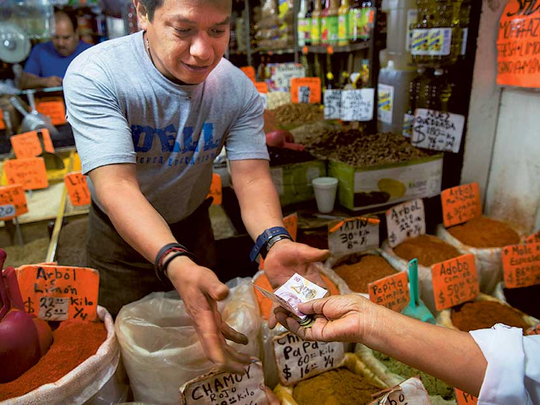
New York/Singapore: This month’s advance in emerging-market currencies is turning into the rally no one seems to like.
An index of 20 developing-nation exchange rates is at an almost two-month high, recovering from a record low on growing speculation the Federal Reserve will keep interest rates near zero until next year. Yet Credit Suisse Group AG, Pacific Investment Management Co. and Citigroup Inc. say the gains will prove fleeting, and most forecasters agree: All 23 emerging- market currencies tracked by Bloomberg are projected to weaken against the dollar by the first quarter, according to the latest analysts’ forecasts.
Scepticism about the advance comes in part from the darkening global economic outlook after two months of disappointing US job growth. Fading American demand for developing countries’ exports tends to undermine their currencies. The emerging-market index’s worst year since the 1990s — a 14 per cent drop in 2008 — came during the most recent US recession.
“We don’t see this as the beginning of a trend change,” said Shahab Jalinoos, global head of foreign-exchange strategy in New York at Credit Suisse. “There’s a short lifespan” to a rally in emerging markets while developed economies struggle, he said.
The emerging-market currency index, whose components include the Brazilian real and the Thai baht, climbed for a sixth straight day Friday, paring its 2015 loss to 9.6 per cent. The gauge has risen 3.3 per cent this week, set for the biggest gain since Feb. 1998.
Jobs Trigger
The trigger for the rally also serves to explain why the gains may be short-lived. The advance picked up steam after a government report showing the US added 142,000 jobs in September, compared with the 200,000 median forecast in a Bloomberg survey of economists. Employment growth trailed projections in August as well.
Traders are pricing in a 39 per cent probability that the Fed raises rates by its December meeting, down from 60 per cent a month ago, according to futures data compiled by Bloomberg. The calculation is based on the assumption that the effective fed funds rate will average 0.375 per cent after lift-off. Higher US interest rates hurt the relative appeal of emerging-market assets.
“The reason you’ve had this recovery in higher-yielding currencies is you’ve had this setback for Fed expectations,” said Daniel Katzive, head of foreign-exchange strategy for North America at BNP Paribas SA. “But if you think what the driver for that setback is, it’s external headwinds outside the US Those same external headwinds are likely to continue impacting emerging markets.”
Precarious Recovery
The currencies’ recovery is precarious given developing nations’ dependence on the world’s biggest economies, according to Credit Suisse and BNP. A commodities rout and waning Chinese demand have already led to contraction in manufacturing measures for some nations, Markit Economics data show.
“Emerging markets in general struggle to find a growth model outside of exports and commodities,” Michael Gomez, head of emerging-markets portfolio management at Newport Beach, California-based Pimco, wrote in a report released this week.
Franklin Templeton’s Michael Hasenstab, who’s well known for making contrarian bets, however, said this week the recent sell-off in emerging-market assets has opened up investment opportunities not seen for decades. The San Mateo, California- based money manager is buying the Mexican peso, Malaysian ringgit and Indonesian rupiah, while avoiding assets in Turkey, South Africa and Russia.
Rough Diamonds
“We are not buying everything,” Hasenstab said in an interview posted on YouTube. “There are a handful that have been caught up in the turmoil that we think are diamonds in the rough.”
Morgan Stanley also sees a way to tap into the rally, although it anticipates that the gains will eventually fade. In a note this week, the bank recommended buying currencies of countries with robust growth potential, such as Mexico’s peso and India’s rupee. Yet developing nations remain vulnerable amid “subdued demand in the rest of the world,” according to the New York-based bank.
“Without a pickup in growth, net capital outflows will remain negative and drive currency weakness,” strategists including Gordian Kemen wrote in a research note published Wednesday.
The rally is unlikely to last long as growth concerns in emerging markets and China remain, according to Citigroup, the world’s biggest foreign-exchange trader. A more solid rebound in commodities is needed, analysts at the U.S lender led by Dirk Willer, New York-based head of emerging-market fixed-income strategy, wrote in an October 8 report.
“What we’re having is a magnificent dead-cat bounce,” said Michael Every, the Hong Kong-based head of financial markets research at Rabobank Group. “The underlying problems have not gone away in any way, shape or form. We had maybe gone too bearish too quickly before but now we’re getting too bullish too fast.”












